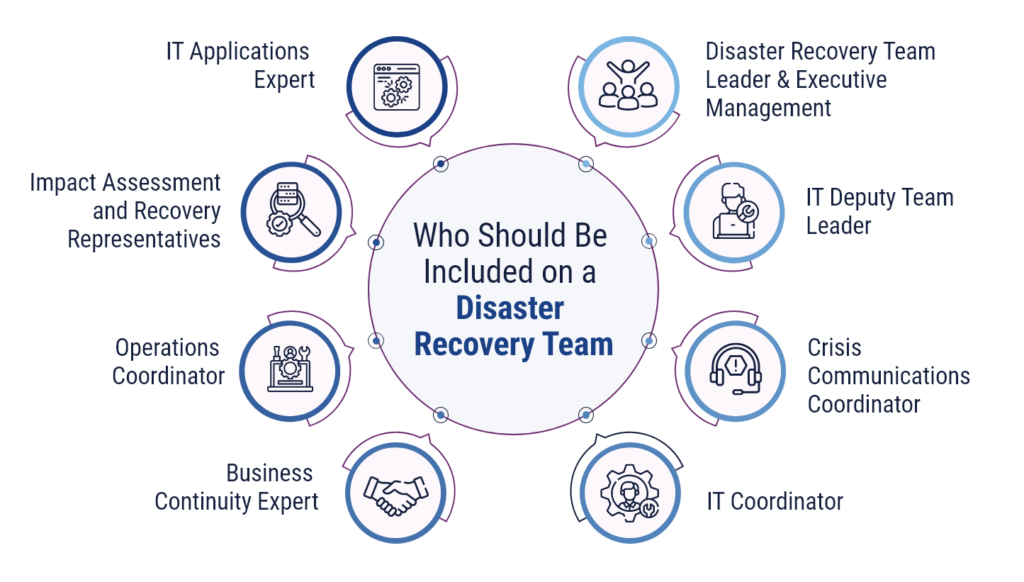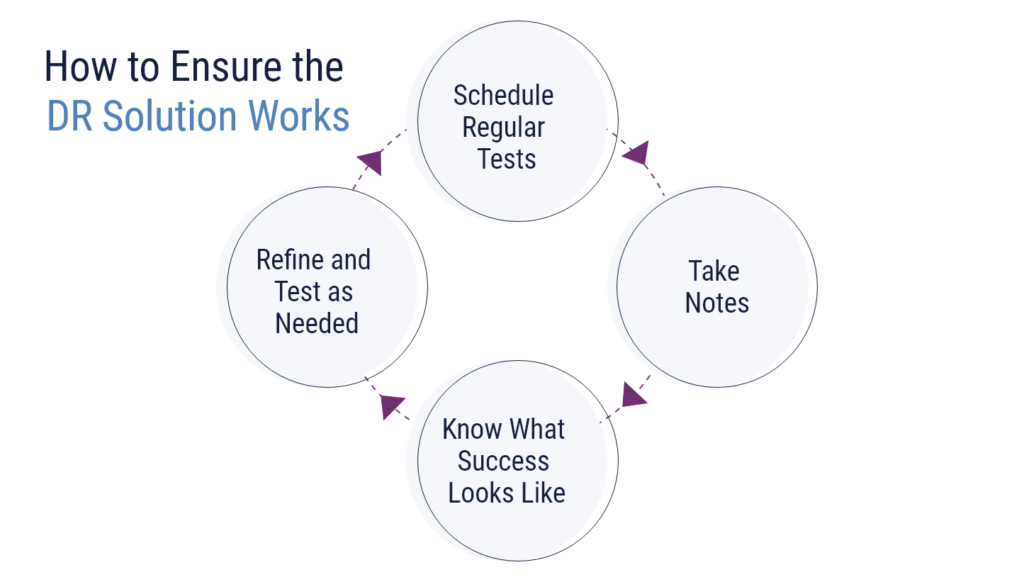April 27, 2023 | Channing Lovett
What Is A Disaster Recovery Team: Roles For A Successful Plan

Oftentimes, it’s not the scale or type of disaster that determines the impact on organizations. Instead, it comes down to how businesses respond to different disasters. Developing proper disaster recovery plans (DRP), as well as testing and maintaining them regularly, can help keep your business afloat in the face of adversity. Building a disaster recovery team can make the process a priority and better prepare the rest of your organization for how to respond in emergency situations.
We’ll talk about what a disaster recovery team is, who should be included, and what to do if you don’t have adequate in-house resources to fill out a team.
What is a Disaster Recovery Team?
A disaster recovery team is responsible for creating, implementing, testing, and maintaining a business’ disaster recovery plan. The team should consist of people from all major parts of the organization as part of a strong risk management and failover strategy.
Why a Disaster Recovery Team is Key to Executing a Plan Successfully
A disaster recovery plan is nothing without the team backing it. Members of the team are essential to the proper execution of the plan. They should have the authority, availability and decision-making abilities to snap to action when faced with a disaster and be familiar enough with the plan and the various duties detailed to carry out what has been set in place.
Who Should Be Included on a Disaster Recovery Team

A mix of people from different departments and skill sets should be included in a disaster recovery team. The size and complexity of the organization will also somewhat dictate who is included, as well the skills assigned to specific people in the event of a disaster.
Disaster Recovery Team Leader & Executive Management
Overall planning and execution of the DRP, including the disaster declaration, is the job of the disaster recovery team leader. They are in charge of coordinating all efforts to recover the organization’s critical systems and data. During the process of planning, they are also responsible for identifying which pieces are critical for recovery efforts, leading the development of the plan, and dictating how it gets tested regularly.
Executive management should work alongside the team leader to ensure they have what they need to carry out their plans as outlined. This can include approving budgets or helping allocate resources for the disaster recovery process.
IT Deputy Team Leader
The IT deputy team leader works alongside the head leader, organizing the operations of the team and assisting in the planning and execution of the disaster recovery plan. They may oversee the project, manage the budget, troubleshoot problems uncovered in the testing process, and more.
Crisis Communications Coordinator
When a business is facing disaster, it’s important to have someone on-staff communicate what has happened and what the plan is moving forward to both inside and outside points of contact. A person in charge of crisis communications would create responses for various scenarios, outline how the information will be disseminated, and assign parties who will be responsible for sharing information across their departments or groups. Getting out in front of a problem and working with a proactive communicator can lessen the impact of any disaster and help protect the company’s reputation.
IT Coordinator
Depending on the size of the organization, an IT coordinator might work directly with the leader or with a deputy to develop and maintain the disaster recovery plan. They would also implement the plan created by the leader and deputy and be responsible for communicating the plan to all employees, which would be crafted jointly by the IT leader and the crisis communications coordinator.
Business Continuity Expert
A business continuity expert is concerned with how to keep things moving in the face of disruption. Someone who occupies this role would have a background in IT, business, or emergency management, and would be good at thinking about how complex systems work together. They may work with the leader, deputy, and IT coordinator to develop risk assessments and tests that can evaluate the effectiveness of disaster recovery plans in ensuring business continuity.
Operations Coordinator
Operations coordinators are process-oriented. All best practices, plan documentation, and drills are arranged and documented by operations coordinators. They may run practice drills with the organization and are likely to work closely with other members of the group to confirm they are documenting and preparing for all possible scenarios. During a disaster, they’re also responsible for ensuring an alternate working plan and access for employees.
Impact Assessment and Recovery Representatives
Specialists can play an important part in the overall disaster recovery plan, advocating for their pieces of infrastructure to verify that the plans should work as outlined and testing plans against specific components.
Your organization may have separate infrastructure representatives for your network, servers, storage, and database. These representatives prioritize their components and focus on what needs to be working first to favor business operations. They may be responsible for developing timely strategies for the components they represent, assessing equipment, testing & maintaining components, and communicating plans or necessary fixes to their entire team.
IT Applications Expert
In the planning and maintenance stages, the applications experts look specifically at the software in a system to identify what’s going wrong or where improvements might be made. During testing, an IT applications expert can help by evaluating how applications operate after an event, and determining how application problems can be solved. In the event of an actual declaration, the IT applications expert is responsible for validating that all applications are working as expected to resume normal business operations.
Disaster Recovery Planning
It’s with the disaster recovery team that an organization is able to assemble a solid disaster recovery plan. Anything that disrupts a business’ normal operations, such as a cyberattack, power outage, or natural disaster, should be considered in the planning process.
A disaster recovery checklist can serve as a helpful planning aid, identifying the critical systems and data to check steps that need to be taken in the recovery process, and what needs to be tested regularly to ensure it is effective when a disaster strikes.
The team will also take this checklist and maintain it, updating it as new components or weaknesses are identified.
Innovative Disaster Recovery Team Training and Readiness
The training that goes into a disaster recovery team will determine their degree of readiness. Teams need to be aware of the hazards and risks common to their industry and location, as well as how to respond to specific threats. While the disaster recovery process is initially set in the planning stage, it’s solidified in the testing and maintenance stages.
A Proactive Approach to Disaster Response
Proactive action and communication are key to any disaster response. If a team is trained and ready, they can respond faster to any disaster, getting messages out to internal team members and external stakeholders quickly. The faster communication gets out, the more an organization can calm any concerns. It’s through proactive action and communication that businesses can instill a feeling of trust and calm in affected parties.
However, the opposite can also be true. Going silent during times of crisis can shake the confidence of people inside and outside the organization, which can cause permanent damage to your reputation and trust. A rapid, well-thought-out response is ideal.

Continuous Improvement Mindset for Disaster Recovery Teams
Disaster recovery planning is not a one-time event. It’s an ongoing process that leaves room for continuous improvement. Your disaster recovery team should carry this mindset into the testing and maintenance of the plan. During testing, the disaster recovery team has the opportunity to unearth potential problems and solve them before they cause larger problems. Through continuous check-ins and iterative improvements, your organization stands the best chance at protecting itself in a disaster scenario.
Building Your Expert Disaster Recovery Team with TierPoint
If you want to build a team but feel you lack the in-house skills and resources, you can use a service provider to bring in outside expertise to assist your team TierPoint can serve as your outsourced disaster recovery team, provide disaster recovery as a service (DRaaS), or offer consulting services that fill in the gaps to best support the in-house team you’ve built. We can help you build business resiliency, develop an airtight disaster recovery plan, and add tools to your organization for more control over your recovery plan. Contact us today for more information.
FAQs
A disaster recovery team is responsible for creating, implementing, testing, and maintaining a disaster recovery plan. This plan details the steps an organization will take to recover from different types of disasters.
Organizations that are struggling to find the proper in-house resources or expertise for disaster recovery can choose to work with a consulting firm. Providers like TierPoint can augment your existing team and lend their experience to creating a plan that will ensure quick and effective recovery.

